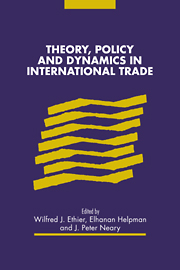Book contents
- Frontmatter
- Contents
- List of conference participants
- I Introduction
- II History, geography and the theory of trade
- III The structure of simple trade models
- 6 Job market preferences and international trade
- 7 Production indivisibilities in a short-run trade model
- 8 Firms, entry and hysteresis in the Heckscher–Ohlin–Samuelson model of production and trade
- IV Policy towards international trade
- V Trade, growth and dynamics
- Index
6 - Job market preferences and international trade
Published online by Cambridge University Press: 16 March 2010
- Frontmatter
- Contents
- List of conference participants
- I Introduction
- II History, geography and the theory of trade
- III The structure of simple trade models
- 6 Job market preferences and international trade
- 7 Production indivisibilities in a short-run trade model
- 8 Firms, entry and hysteresis in the Heckscher–Ohlin–Samuelson model of production and trade
- IV Policy towards international trade
- V Trade, growth and dynamics
- Index
Summary
The hallmark of Ronald W. Jones's pioneering contributions to trade theory has been his extraordinary ability to capture the essence of a problem in a simple, elegant fashion. From my graduate-student days I can recall the young Ron Jones on the circuit in the spring of 1965 promoting his classic paper (Jones, 1965) on “Simple General Equilibrium Models.” We should remember that these were the days when the abstract school of general equilibrium ruled the world. The message I got from the talk is that something could be done with general equilibrium. Everything was not possible: dual magnification effects ruled Jones's world. The anything could-happen school of general equilibrium theorists thought this was heresy, and that something had to be wrong – it was just too neat! Today, the abstract school of general equilibrium is in retreat, and simple general equilibrium models are found in macroeconomics, economic history, public finance, and industrial organization.
While Jones made his mark with Heckscher–Ohlin, his Ricardian credentials have been impeccable (Jones, 1961). In the present paper I try to apply a simple Ricardian model to bringing out the role of job-market preferences in international trade. One of the standard assumptions of trade theory has always been that labor is indifferent between equal-paying jobs. But workers have preferences for different jobs. Adam Smith succinctly summarized the theory of compensating wage differentials: “The wages of labour vary with the ease or hardship, the cleanliness or dirtiness, the honourableness or dishonourablenes of the employment.” This theory has been disputed in recent years (Krueger and Summers, 1988), but it still has defenders (Rosen, 1986; Murphy and Topel, 1987, and Ruffin, 1990b).
- Type
- Chapter
- Information
- Theory, Policy and Dynamics in International Trade , pp. 75 - 90Publisher: Cambridge University PressPrint publication year: 1993

